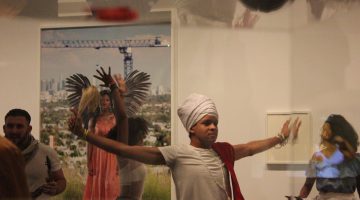While sitting in the audience of Erin Markey’s show at Joe’s Pub last week I heard someone behind me say “…of course it was amazing, Erin is a performance artiste!” I turned to the person next to me and asked about it—an awkward “what does performance art mean to you” moment I never tire of. He clarified: “Erin doesn’t want to be called a performance artist—its too limiting, it makes her seem too downtown, too small audience.”
Erin Markey’s energy, her sensibility, is so singularly constructed for herself that it couldn’t be transferred to another person, maybe that is one thing people mean in calling her a performance artist. She plays “Erin Markey” as an outsized persona through autobiographical sketches interlaced with musical numbers—a tried and true nightclub strategy. The songs, usually contemporary pop songs, are performed with an intensity that unravels them. Like Sandra Bernhard (Without You I’m Nothing influenced performance art in ways never acknowledged) Markey is an athletic young white woman who dares you to objectify her. There is a queer ferocity in her interpretations of sexist hits, like her transformation of Bruno Mars’ dulcet “Grenade” into an intoxicating incantation, embodying the “mad woman, bad woman” of the lyrics in a way that is closer to Mary Wigman’s Hexantanz than to any of our candy-coated popstars. Her performances are tightly woven from several tiers of cultural reference unified by a relentless emotional continuity. For instance “Grenade” begins and ends with Mama Rose from “Gypsy” with the middle seamlessly breaking into a few lines of Bette Middler’s “Wind Beneath My Wings.” Her take on Ursher’s “Daddys Home” begins with a long story about being traumatized by a made-for-TV movie “David” where a father sets his sleeping son on fire. In this context the “sexuality” of the song cannot escape a sense of the disturbing.
What struck me most was a performance of Jewel’s “Foolish Games” she talked about the exhilarating experience of having hands laid on her in an evangelical church as a teenager. Later I told her that my interest in “performance art” is similarly connected to growing up in a Pentecostal church—speaking in tongues, laying on hands, dancing and singing all night—because even though I don’t believe it was connected to “god” I do know that I felt something powerful. She said: “It was the most permission I ever felt to be publicly emotional in my entire life, to date. At the same time I was terrified that I didn’t truly believe it.”
This reminds me of something said by the greatest performance artist of the late-20th century, Dolly Parton, who uses a baroque facade to articulate the most sensitive authenticity: “part of the magic is that I look so totally artificial but I am so totally real.”
—Contributed by Jarrett Earnest




